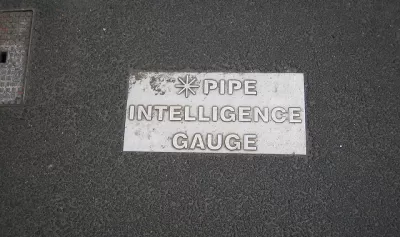Sensing capabilities and advanced building materials are redefining the resilience of infrastructure systems of all kinds.

Infrastructure in the modern age is practically a living organism. Research into more rugged and weatherproof building materials, safer and more reliable manufacturing techniques, and even advancements in computer technologies has made public and private infrastructure truly a marvel.
And now the availability of meaningful data could bring infrastructure into a brand-new and even more impressive era. And why not? It still might be hard to believe, but data has emerged as one of the most valuable commodities on planet Earth.
For consideration today is an unlikely pairing of vulnerable infrastructure with modern data and impressive new building materials. The result is a kind of "smart piping" that has the potential to benefit towns and cities in a big way, even long after gas pipelines are left behind.
What problems does smart technology solve?
There are still plenty of skeptics who might question whether machine learning and automation should necessarily be applied to something as vital as infrastructure. But once you begin to understand the benefits data and "smart technology" can bring to this field, you might wonder how people did without it for so long.
In terms of practical, real-world applications, the smart technologies discussed today could help address challenges like these:
- Many of America's roads and bridges are either structurally unsafe or close to it. Smart technology, including sensors and networked computers, can allow us to monitor the health of these structures in real-time and over an extended period.
- For pipeline applications, smart technology is all about safety. By introducing advanced sensor systems to particularly sensitive lengths of pipeline, engineers can better anticipate factors that might result in leakages, such as natural disasters like earthquakes or floods, temperature extremes, land movement, changes in the water table, and general wear and tear.
As you can tell, the environment is the primary antagonist in most of these scenarios. Similar to how other kinds of equipment need the right amount of ambient pressure to function, pipelines are sensitive to their environments and have previously reacted in ways people have struggled to predict.
Modern sensors and notification systems let you stay ahead of some of these challenges and hopefully avoid some of the kinds of damage seen in the past, where safety checks and oversights weren't up to the task.
What is "smart piping"?
That's right: sensors are going to change infrastructure forever.
The minds behind this emerging technology hail from Cornell Geotechnical Lifelines Large-Scale Testing Facility. That's a complicated name for a place with a straightforward mandate—to make sensitive infrastructure more impervious to the kinds of harm discussed above.
Applying these ideas to underground structures like pipelines is relatively uncharted territory, but the team at Cornell thinks they've cracked it, thanks to sensors developed at other top-tier schools like the University of California, Berkeley, and the University of Cambridge.
These sensors measure:
- Ongoing strain on physical structures.
- Temperature fluctuations.
- Previous and existing drifting or movement in the surrounding soil.
- Intermittent or constant leakage from the structure itself.
The teams installed these sensors on a stretch of pipeline whose performance they wanted to evaluate under earthquake-like conditions. Testing produced conditions similar to an earthquake, thanks to a purpose-built testing facility in Ithaca, New York.
As for the pipeline itself, its physical structure [pdf] employed a polyvinylchloride-based material that reacts peculiarly under the influence of extreme forces. Put more simply, the pipeline has the uncommon ability to withstand forces that would ruin pipelines built from more conventional materials.
So what about the results? According to Cornell representative Brad Wham, "It was a fantastic performance." The data indicated this length of pipeline was able to handle 50 percent more disturbance in the surrounding soil than previous design iterations.
Why digital is the future of physical infrastructure?
As you can tell, these breakthroughs stand on two significant pillars of scientific inquiry:
- The search for stronger, lighter, and more resilient building materials.
- The digital tools to monitor their performance out in the field and hopefully anticipate future disruptions.
Needless to say, national priorities have turned top minds to the task of developing stronger piping materials for oil and natural gas applications. The pipeline above, prepared by a company called IPEX, is one such example.
And there have been many others. The safety of natural gas pipelines today, for instance, far outstrips what they were capable of in past decades, thanks in part to new materials. By comparison, outdated infrastructure in this field is extremely costly, with a price tag of 93 injuries and 18 fatalities in 2014 and $2 billion in lost inventory—in the natural gas industry alone.
But technology holds the answer.
By combining impressive new materials with bleeding-edge digital technologies like networked computers and advanced sensors, exciting success stories are emerging all the time, and in wildly different conditions and scenarios, like these:
- Water usage in orchards on vineyards is a sensitive issue in the more drought-prone areas of the country. Sensors can provide atmospheric and soil data to help us better allocate resources in times of scarcity.
- Natural disasters are difficult to anticipate and harder still to plan for adequately. Technologies like these can help us study and better understand how hurricanes and earthquakes are distributed geographically. With information like that, organizations could improve how they respond to disasters and distribute aid during emergencies.
- Recent headlines drove home how badly even developed nations can fail their citizens when it comes to portable water. In places like Flint, Michigan, where concerns about drinking water went unaddressed, literal pipe-crawling robots could find work studying pipe thickness from the inside and providing condition assessments. These little ‘bots could soon become life-savers.
How do towns and cities benefit?
As has probably been obvious, this technology is about far more than moving oil and gas safely from point A to point B. Let's turn now from country-spanning pipelines to zoom in on the heart of your average modern city.
Think of the benefits of applying more impressive building materials, sensor data, smart robotics, and alert systems to the challenge of maintaining and updating electrical grids, telecommunication networks and water distribution systems. As the world’s weather and climate become more unpredictable, it’s crucial that people keep an eye on the most vulnerable and essential infrastructure.
Brad Wham from Cornell once again: "It's going to be a game-changer," he says. And he's right, the sensors under consideration here provide a level of granularity and detail people have never dreamed of before. You can make more than a thousand measurements in a single second and compare those numbers to other sites across the county or state—or even on another coast.
Networked computers may have delivered plenty of outlandish science-fiction scenarios over the years, but when you apply them to some of the oldest problems, the reality is much brighter. Making sure infrastructure is safe from the whims of nature means people are one step closer to making sure it's distributed to the individuals who need it the most.

Maui's Vacation Rental Debate Turns Ugly
Verbal attacks, misinformation campaigns and fistfights plague a high-stakes debate to convert thousands of vacation rentals into long-term housing.

Planetizen Federal Action Tracker
A weekly monitor of how Trump’s orders and actions are impacting planners and planning in America.

In Urban Planning, AI Prompting Could be the New Design Thinking
Creativity has long been key to great urban design. What if we see AI as our new creative partner?

King County Supportive Housing Program Offers Hope for Unhoused Residents
The county is taking a ‘Housing First’ approach that prioritizes getting people into housing, then offering wraparound supportive services.

Researchers Use AI to Get Clearer Picture of US Housing
Analysts are using artificial intelligence to supercharge their research by allowing them to comb through data faster. Though these AI tools can be error prone, they save time and housing researchers are optimistic about the future.

Making Shared Micromobility More Inclusive
Cities and shared mobility system operators can do more to include people with disabilities in planning and operations, per a new report.
Urban Design for Planners 1: Software Tools
This six-course series explores essential urban design concepts using open source software and equips planners with the tools they need to participate fully in the urban design process.
Planning for Universal Design
Learn the tools for implementing Universal Design in planning regulations.
planning NEXT
Appalachian Highlands Housing Partners
Mpact (founded as Rail~Volution)
City of Camden Redevelopment Agency
City of Astoria
City of Portland
City of Laramie






























